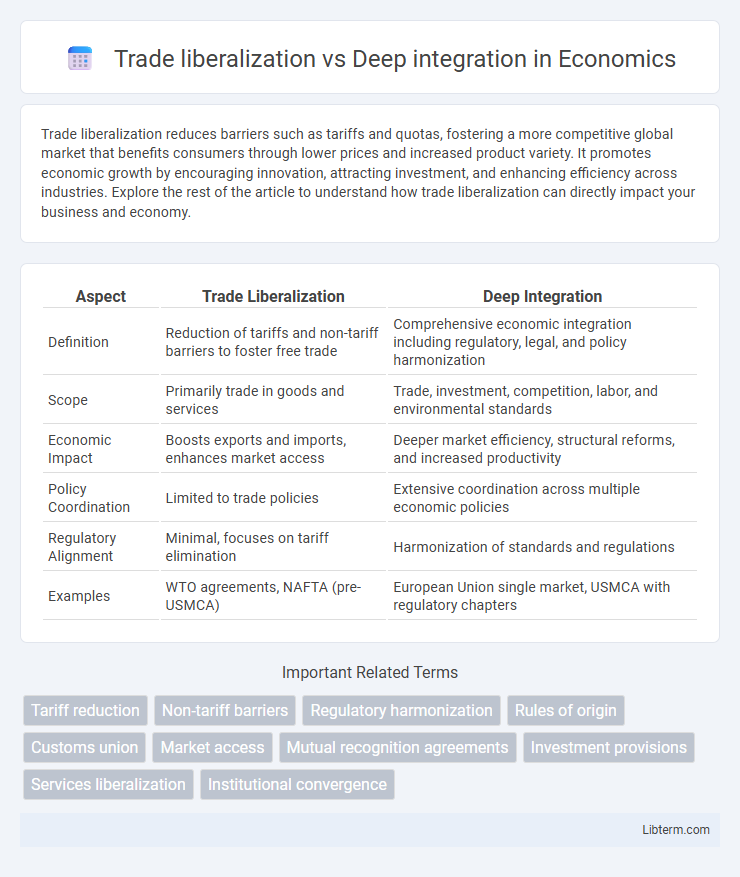Trade liberalization reduces barriers such as tariffs and quotas, fostering a more competitive global market that benefits consumers through lower prices and increased product variety. It promotes economic growth by encouraging innovation, attracting investment, and enhancing efficiency across industries. Explore the rest of the article to understand how trade liberalization can directly impact your business and economy.
Table of Comparison
| Aspect | Trade Liberalization | Deep Integration |
|---|---|---|
| Definition | Reduction of tariffs and non-tariff barriers to foster free trade | Comprehensive economic integration including regulatory, legal, and policy harmonization |
| Scope | Primarily trade in goods and services | Trade, investment, competition, labor, and environmental standards |
| Economic Impact | Boosts exports and imports, enhances market access | Deeper market efficiency, structural reforms, and increased productivity |
| Policy Coordination | Limited to trade policies | Extensive coordination across multiple economic policies |
| Regulatory Alignment | Minimal, focuses on tariff elimination | Harmonization of standards and regulations |
| Examples | WTO agreements, NAFTA (pre-USMCA) | European Union single market, USMCA with regulatory chapters |
Introduction to Trade Liberalization and Deep Integration
Trade liberalization involves reducing tariffs, quotas, and other trade barriers to promote the free flow of goods and services between countries, aiming to enhance market efficiency and economic growth. Deep integration goes beyond traditional trade liberalization by harmonizing regulations, standards, and policies across borders to create a more comprehensive and seamless economic union. This approach addresses non-tariff barriers and fosters deeper economic cooperation, enabling countries to benefit from more integrated supply chains and improved competitiveness.
Key Definitions and Core Concepts
Trade liberalization refers to the removal or reduction of tariffs, quotas, and non-tariff barriers to promote the free flow of goods and services across borders, emphasizing market access and efficiency gains. Deep integration involves harmonizing regulatory frameworks, standards, and policies beyond mere trade barriers, targeting comprehensive economic convergence and institutional cooperation among countries. Both concepts play pivotal roles in shaping international economic relations, with trade liberalization centered on border measures and deep integration fostering structural alignment and sustainable regional economic integration.
Historical Evolution of Trade Policies
Trade liberalization historically began with unilateral tariff reductions and bilateral agreements, emphasizing the removal of trade barriers to enhance market access. Deep integration emerged as a more comprehensive approach in the late 20th century, involving not only tariff cuts but also harmonization of regulations, standards, and policies to address behind-the-border obstacles. Key milestones include the General Agreement on Tariffs and Trade (GATT) fostering liberalization, followed by World Trade Organization (WTO) frameworks and regional trade agreements advancing deep integration.
Primary Goals of Trade Liberalization
Trade liberalization primarily aims to reduce tariffs, quotas, and other barriers to promote increased international trade and market access. It seeks to stimulate economic growth, improve efficiency, and provide consumers with a wider variety of goods at lower prices. By fostering competition and encouraging specialization, trade liberalization enhances productivity and global supply chain integration.
Objectives and Scope of Deep Integration
Deep integration aims to harmonize regulatory standards, reduce non-tariff barriers, and create cohesive policies across countries to facilitate seamless economic cooperation beyond traditional tariff reductions seen in trade liberalization. Its scope extends to areas such as intellectual property rights, labor laws, environmental standards, and digital trade regulations, fostering a comprehensive and sustainable cross-border economic environment. By addressing behind-the-border measures, deep integration supports deeper market access and stronger regional value chains compared to the limited focus of trade liberalization on tariff elimination.
Benefits and Challenges of Trade Liberalization
Trade liberalization promotes increased market access and economic growth by reducing tariffs and non-tariff barriers, fostering competition and innovation among industries. Challenges include potential job displacement in vulnerable sectors and disparities in income distribution, which may require policy adjustments to mitigate social impacts. Despite these challenges, trade liberalization enhances consumer choice and efficiency, contributing significantly to global supply chain integration.
Advantages and Limitations of Deep Integration
Deep integration enhances economic cooperation by addressing non-tariff barriers, harmonizing regulations, and fostering deeper policy coordination among countries, which leads to more efficient supply chains and stronger investment flows. However, it requires significant sovereignty concessions, complex legal frameworks, and often faces political resistance due to the need for aligning diverse regulatory standards. While trade liberalization mainly reduces tariff barriers, deep integration's comprehensive approach can unlock greater economic growth but demands robust institutional capacities and long-term commitment.
Comparative Analysis: Trade Liberalization vs Deep Integration
Trade liberalization primarily focuses on reducing tariffs and non-tariff barriers to facilitate cross-border trade, enhancing market access and price competitiveness. Deep integration extends beyond traditional trade liberalization by harmonizing regulations, standards, and policies to create seamless economic interactions, leading to more substantial economic convergence among participating countries. Comparative analysis reveals that while trade liberalization boosts short-term trade volumes, deep integration fosters long-term economic resilience, innovation, and institutional collaboration.
Case Studies and Global Examples
Trade liberalization, exemplified by agreements like NAFTA and ASEAN Free Trade Area, reduces tariffs and non-tariff barriers to boost cross-border trade volume, fostering economic growth primarily through market access expansion. Deep integration, seen in the European Union and Comprehensive Economic and Trade Agreement (CETA), goes beyond traditional liberalization by harmonizing regulations, standards, and policies to create seamless supply chains and stronger institutional cooperation. Case studies from the EU reveal that deep integration enhances structural reforms and competitiveness, while NAFTA's trade liberalization model underscores immediate trade flow benefits but less regulatory alignment.
Future Trends and Policy Implications
Trade liberalization focuses on reducing tariffs and non-tariff barriers to boost cross-border commerce, while deep integration emphasizes regulatory harmonization and cooperative policy frameworks beyond mere tariff cuts. Future trends indicate a shift towards digital trade facilitation, sustainability standards, and data governance shaping both approaches, driving nations to adopt comprehensive policies that address complex supply chains and technological interoperability. Policymakers must prioritize multilateral agreements that balance liberal market access with robust regulatory convergence to ensure resilient, equitable, and rules-based global trade systems.
Trade liberalization Infographic

 libterm.com
libterm.com